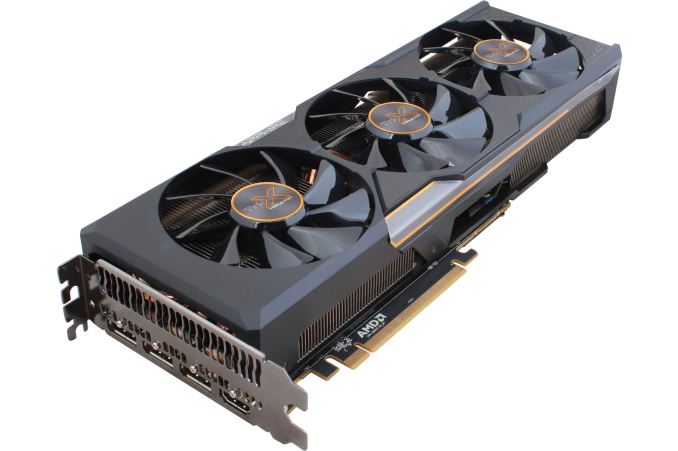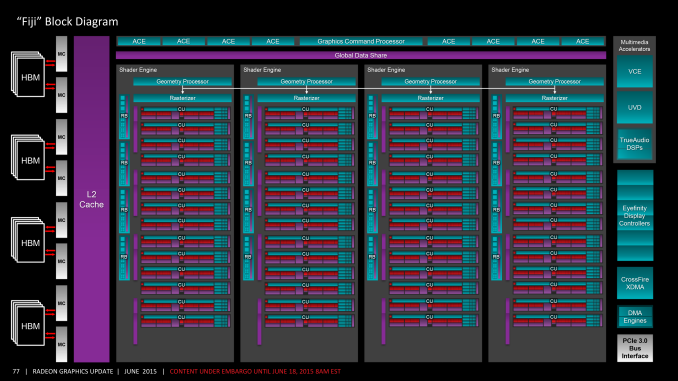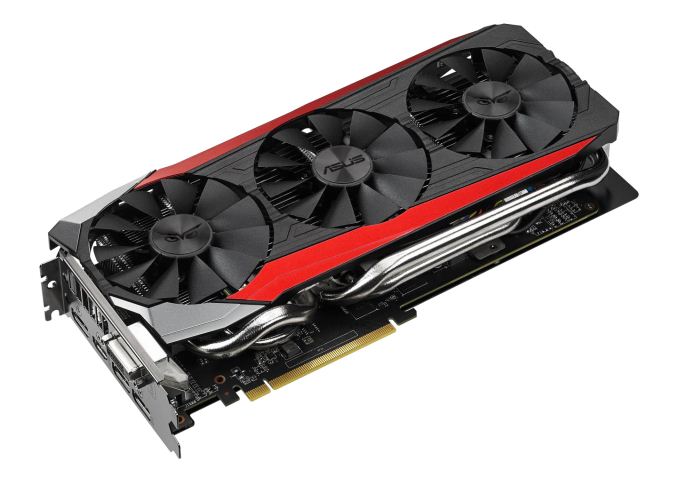The AMD Radeon R9 Fury Review, Feat. Sapphire & ASUS
by Ryan Smith on July 10, 2015 9:00 AM EST
A bit over two weeks ago AMD launched their new flagship video card, the Radeon R9 Fury X. Based on the company’s new Fiji GPU, the R9 Fury X brought with it significant performance improvements to AMD’s lineup, with AMD’s massive Fiji greatly increasing the card’s shading resources. Meanwhile Fiji also marked the introduction of High Bandwidth Memory (HBM) in to consumer products, giving the R9 Fury X a significant leg up in memory bandwidth. Overall AMD put together a very impressive card, however at $649 it fell just short of the GeForce GTX 980 Ti AMD needed it to beat.
Meanwhile alongside the announcement of the R9 Fury X, AMD announced that there would be three other Fiji-based cards. These include the R9 Fury, the R9 Nano, and a yet-to-be-named dual-GPU Fiji card. The first of these remaining cards to launch would be the R9 Fury, the obligatory lower-tier sibling to AMD’s flagship R9 Fury X. Today we will be taking a look at the first of those remaining cards, the R9 Fury, which launches next week.
While R9 Fury X remains the fastest Fiji card – and by virtue of being introduced first, the groundbreaking card – the impending launch of the R9 Fury brings with it a whole slew of changes that make it an interesting card in its own right, and a very different take on a Fiji product altogether. From a performance standpoint it is a lower performing card, featuring a cut-down Fiji GPU, but at the same time it is $100 cheaper than the R9 Fury X. Meanwhile in terms of construction, unlike the R9 Fury X, which is only available in its reference closed loop liquid cooling design, the R9 Fury is available as semi-custom and fully-custom cards from AMD’s board partners, built using traditional air coolers, making this the first air cooled Fiji card. As a result the R9 Fury at times ends up being a very different take on Fiji, for all of the benefits and drawbacks that comes with.
| AMD GPU Specification Comparison | ||||||
| AMD Radeon R9 Fury X | AMD Radeon R9 Fury | AMD Radeon R9 290X | AMD Radeon R9 290 | |||
| Stream Processors | 4096 | 3584 | 2816 | 2560 | ||
| Texture Units | 256 | 224 | 176 | 160 | ||
| ROPs | 64 | 64 | 64 | 64 | ||
| Boost Clock | 1050MHz | 1000MHz | 1000MHz | 947MHz | ||
| Memory Clock | 1Gbps HBM | 1Gbps HBM | 5Gbps GDDR5 | 5Gbps GDDR5 | ||
| Memory Bus Width | 4096-bit | 4096-bit | 512-bit | 512-bit | ||
| VRAM | 4GB | 4GB | 4GB | 4GB | ||
| FP64 | 1/16 | 1/16 | 1/8 | 1/8 | ||
| TrueAudio | Y | Y | Y | Y | ||
| Transistor Count | 8.9B | 8.9B | 6.2B | 6.2B | ||
| Typical Board Power | 275W | 275W | 250W | 250W | ||
| Manufacturing Process | TSMC 28nm | TSMC 28nm | TSMC 28nm | TSMC 28nm | ||
| Architecture | GCN 1.2 | GCN 1.2 | GCN 1.1 | GCN 1.1 | ||
| GPU | Fiji | Fiji | Hawaii | Hawaii | ||
| Launch Date | 06/24/15 | 07/14/15 | 10/24/13 | 11/05/13 | ||
| Launch Price | $649 | $549 | $549 | $399 | ||
Starting things off, let’s take a look at the specifications of the R9 Fury. As we mentioned in our R9 Fury X review, we have known since the initial R9 Fury series launch that the R9 Fury utilizes a cut-down Fiji GPU, and we can now reveal just how it has been cut down. As is usually the case for these second-tier cards, the R9 Fury features both a GPU with some functional units disabled and a slightly reduced clockspeed, allowing AMD to recover partially defective GPUs while easing up on the clockspeed requirements.
The Fiji GPU in the R9 Fury ends up having 56 of 64 CUs enabled, which brings down the total stream processor count from 4,096 to 3,584. This in turn ends up being the full extent of the R9 Fury’s disabled functional units, as AMD has not touched the front-end or back-end, meaning the number of geometry units and the number of ROPs remained unchanged.
Also unchanged is the memory subsystem. All Fiji-based cards, including the R9 Fury, will be shipping with a fully enabled memory subsystem, meaning we’re looking at 4GB of HBM attached to the GPU over a 4096-bit memory bus. With Fiji topping out at just 4GB of memory in the first place – one of the drawbacks faced by the $650 R9 Fury X – cutting back on memory here to a smaller capacity is not a real option for AMD, so every Fiji card will come with that much memory.
As for clockspeeds, R9 Fury takes a slight trim on the GPU clockspeed. The reference clockspeed for the R9 Fury is a flat 1000MHz, a 5% reduction from the R9 Fury X. On the other hand the memory clock remains unchanged at 500MHz DDR, for an effective memory rate of 1Gbps/pin.
All told then, on paper the performance difference between the R9 Fury and R9 Fury X will stand to be between 0% and 17%; that is, the R9 Fury will be up to 17% slower than the R9 Fury X. In the best case scenario for the R9 Fury of a memory bandwidth bottleneck, it has the same 512GB/sec of memory bandwidth as the R9 Fury X. At the other end of the spectrum, in a shader-bound scenario, the combination of the reduction in shader hardware and clockspeeds is where the R9 Fury will be hit the hardest, as its total FP32 throughput drops from 8.6 TFLOPs to 7.17 TFLOPs. Finally in the middle, workloads that are front-end or back-end bound will see a much smaller drop since those units haven’t been cut-down at all, leading to just a 5% performance drop. As for the real world performance drop, as we’ll see it’s around 7%.
Power consumption on the other hand is going to be fairly similar to the R9 Fury X. AMD’s official Typical Board Power (TBP) for the R9 Fury is 275W, the same as its older sibling. Comparing the two products, the R9 Fury sees some improvement from the disabled CUs, however as a second-tier part it uses lower quality chips overall. Meanwhile the use of air cooling means that operating temperatures are higher than the R9 Fury X’s cool 65C, and as a result power loss from leakage is higher as well. At the end of the day this means that the R9 Fury is going to lose some power efficiency compared to the R9 Fury X, as any reduction in power consumption is going to be met with a larger decrease in performance.
Moving on, let’s talk about the cards themselves. With the R9 Fury X AMD has restricted vendors to selling the reference card, and we have been told it will be staying this way, just as it was for the R9 295X2. On the other hand for R9 Fury AMD has not even put together a complete reference design, leaving the final cards up to their partners. As a result next week’s launch will be a “virtual” launch, with all cards being semi or fully-custom.
Out of the gate the only partners launching cards are Sapphire and Asus, AMD’s closest and largest partners respectively. Sapphire will be releasing stock and overclocked SKUs based on a semi-custom design that couples the AMD reference PCB with Sapphire’s Tri-X cooler. Asus on the other hand has gone fully-custom right out of the gate, pairing up a new custom PCB with one of their DirectCU III coolers. Cards from additional partners will eventually hit the market, but not until later in the quarter.
The R9 Fury will be launching with an MSRP of $549, $100 below the R9 Fury X. This price puts the R9 Fury up against much different competition than its older sibling; instead of going up against NVIDIA’s GeForce GTX 980 Ti, the closest competition will be the older GeForce GTX 980. The official MSRP on that card is $499, so the R9 Fury is more expensive, but in turn AMD is promising better performance than the GTX 980. Otherwise NVIDIA’s partners serve to fill that $50 gap with their higher-end factory overclocked GTX 980 cards.
Finally, today’s reviews of the R9 Fury are coming slightly ahead of the launch of the card itself. As previously announced, the card goes on sale on Tuesday the 14th, however the embargo on the reviews is being lifted today. AMD has not officially commented on the launch supply, but once cards do go on sale, we’re expecting a repeat of the R9 Fury X launch, with limited quantities that will sell out within a day. After that, it seems likely that R9 Fury cards will remain in short supply for the time being, also similar to the R9 Fury X. R9 Fury X cards have come back in stock several times since the launch, but have sold out within an hour or so, and there’s currently no reason to expect anything different for R9 Fury cards.
| Summer 2015 GPU Pricing Comparison | |||||
| AMD | Price | NVIDIA | |||
| Radeon R9 Fury X | $649 | GeForce GTX 980 Ti | |||
| Radeon R9 Fury | $549 | ||||
| $499 | GeForce GTX 980 | ||||
| Radeon R9 390X | $429 | ||||
| Radeon R9 290X Radeon R9 390 |
$329 | GeForce GTX 970 | |||
| Radeon R9 290 | $250 | ||||
| Radeon R9 380 | $200 | GeForce GTX 960 | |||
| Radeon R7 370 Radeon R9 270 |
$150 | ||||
| $130 | GeForce GTX 750 Ti | ||||
| Radeon R7 360 | $110 | ||||












288 Comments
View All Comments
CiccioB - Monday, July 13, 2015 - link
The myth, here again!Let's see these numbers of a miraculous vs crippling driver.
And I mean I WANT NUMBNERS!
Or what you are talking about is just junk you are reporting because you can't elaborate yourself.
Come on, the numbers!!!!!!!!!
FlushedBubblyJock - Thursday, July 16, 2015 - link
So you lied loguerto, but the sad truth is amd bails on it's cards and drivers for them FAR FAR FAR sooner than nvidia does.YEARS SOONER.
Get with it bub.
Count Vladimir - Thursday, July 16, 2015 - link
Hard evidence or gtfo.Roboyt0 - Sunday, July 12, 2015 - link
I am very interested to see how much of a difference ASUS' power delivery system will make for (real) overclocking in general once voltage control is available. If these cards act the same as the 290's did, then AMD's default VRM setup could very likely be more than capable of overclocks in the 25% or more range. I'm basing the 25% or more off of my experience with a half dozen reference based R9 290's, default 947MHz core, that would reach 1200 core clock with ~100mV additional. And if you received a capable card then you could surpass those clocks with more voltage.It appears AMD has followed the EXACT same path they did with the 290 and 290X. The 290X always held a slight lead in performance, but the # of GPU components disabled didn't hinder the 290 as much as anyone thought. This is exactly what we see now with the Fury ~VS~ Fury X...overclock the Fury and it's the better buy. All while the Fury X is there for those who want that little bit of extra performance for the premium, and this time you're getting water cooling! It seems like a pretty good deal to me.
Once 3rd party programmers(not AMD) figure out voltage control for these cards, history will likely repeat itself for AMD. Yes, these will run hotter and use more power than their Nvidia counterparts...I don't see why this is a shock to anyone since this is still 28nm and similar enough to Hawaii...What no one seems to mention is the amount of performance increase compared to Hawaii in the same power/thermal envelope..it's a very significant jump.
Whom in the enthusiast PC world really cares about the additional power draw? We're looking at 60-90W under normal load conditions; Furmark is NOT normal load. Unless electricity where you hail from is that expensive, it isn't actually costing you that much more in the long run. If you're in the market for a ~$550 GPU, then you probably aren't too concerned with buying a good PSU. What the FurMark power draw of the Fury X/Sapphire Fury really tell us is that the reference PCB is capable of handling 385W+ of draw. This should give an idea of what the card can do once we are able to control the voltage.
These cards are enthusiast grade and plenty of those users will remove the included cooler for maximum performance. A full cover waterblock is going to be the key to releasing the full potential of Fury(X) just like it was for 290(X). It is a definite plus to see board partners with solid air cooling solutions out of the gate though...Sapphire's cooling solution fares better in temperature AND noise during FurMark than ASUS' when it's pulling 130W additional power! Way to go Sapphire!
My rant will continue concerning drivers. Nvidia has mature hardware with mature drivers. The fact AMD is keeping up, or winning is some instances, is a solid achievement. Go back to a 290(X) review when their primary competition was a 780 Ti, where the 780 Ti was usually winning. Now, the 390(X), that so many are calling a rebranded POS, easily bests the 780 Ti and competes with GTX 980. Nvidia changed architecture, but AMD is still competitive? Another commenter said it best by saying: "An AMD GPU is like a fine wine, and gets better with age."
This tells me 3 things...
1) Once drivers mature, AMD stands to gain solid performance improvements.
2) Adding voltage control to enable actual overclocking will show the true potential of these cards.
3) Add these two factors together and AMD has another winning product.
Lastly we still have DX12 to factor into all of this. Sure, you can say DX12 is too far away, but in actuality it is not. I know there are those people who MUST HAVE the latest and greatest hardware every time something new comes around every ~9 months. However, there are plenty more of us who wait a few generations of GPUs to upgrade. If DX12 brings even a half of the anticipated performance gains and you're in the market, then purchasing this card now, or in the coming months, will be a solid investment for the coming years.
Peichen - Monday, July 13, 2015 - link
Whatever flats your boat. There are still some people like you that believes FX CPUs are faster than i7s and they are what keeps AMD afloat. The rest of us.... we actually consider everything and go Intel & Nvidia.There are 3 fails in your assumptions:
1. Fiji is a much bigger core tied to 4 HBM modules. OC will likely not be as "smooth" as 290X
2. 60-90W is not just cost in electricity. It is also getting a PSU that will supply the additional draw and more fan(s) and better case to get the heat out. Or suffer the heat and noise. The $15-45 a year in additional electricity bill also means you will be in the red in a couple od years.
3. You assume AMD/ATI driver team is still around and will be around a couple of years in the future.
silverblue - Tuesday, July 14, 2015 - link
3. Unless the driver work has been completely outsourced and there's proof of this happening, I'm not sure you can use this as a "fail".Fiji isn't a brand new version of GCN so I don't expect the huge gains in performance that are being touted, however whatever they do bring to the table should benefit Tonga as well, which will (hopefully) distance itself from Tahiti and perhaps improve sales further down the stack.
Count Vladimir - Thursday, July 16, 2015 - link
Honestly, driver outsourcing might be for the best in case of AMD.Oxford Guy - Wednesday, July 15, 2015 - link
The most electrically efficient 3D computer gaming via an ARM chip, right? Think of all the wasted watts for these big fancy GPUs. Even more efficient are text-based games.FlushedBubblyJock - Thursday, July 16, 2015 - link
You forgot he said spend a hundred and a half on a waterblock...for the amd card, for "full potential"..ROFL - once again the future that never comes is very bright and very expensive.
beck2050 - Monday, July 13, 2015 - link
A bit disingenuous as custom cooled over clocked 980s are the norm these days and easily match or exceed Fury, while running cooler with much less power and can be found cheaper. AMD HAS its work cut out.